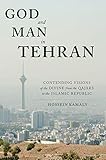God and man in Tehran : contending visions of the divine from the Qajars to the Islamic Republic / Hossein Kamaly.
Material type: TextPublication details: New York : Columbia University Press, (c)2017.Description: 1 online resourceContent type:
TextPublication details: New York : Columbia University Press, (c)2017.Description: 1 online resourceContent type: - text
- computer
- online resource
- 9780231541084
- BP166 .G633 2017
- COPYRIGHT NOT covered - Click this link to request copyright permission: https://lib.ciu.edu/copyright-request-form
| Item type | Current library | Collection | Call number | URL | Status | Date due | Barcode | |
|---|---|---|---|---|---|---|---|---|
 Online Book (LOGIN USING YOUR MY CIU LOGIN AND PASSWORD)
Online Book (LOGIN USING YOUR MY CIU LOGIN AND PASSWORD)
|
G. Allen Fleece Library ONLINE | Non-fiction | BP166.2 (Browse shelf(Opens below)) | Link to resource | Available | on1033405300 |
Browsing G. Allen Fleece Library shelves, Shelving location: ONLINE, Collection: Non-fiction Close shelf browser (Hides shelf browser)
Includes bibliographies and index.
O God, o heaven, o nature -- Mediatory theology and its discontents -- God with us -- The law : God's and man's -- Falsadeh in the Madraseh -- Sufism returns, and with a vengeance -- Varieties of skeptical expression -- Appendix A : names and dates.
In God and Man in Tehran, Hossein Kamaly explores the historical processes that have made and unmade contending visions of God in Iran's capital throughout the past two hundred years. Kamaly examines how ideas of God have been mobilized, contested, and transformed, emphasizing how notions of the divine have given shape to and in turn have been shaped by divergent conceptualizations of nature, reason, law, morality, and authority. God and Man in Tehran analyzes official government policies, modern textbooks, and university curricula; popular beliefs and ritual practices; and philosophical and juridical attitudes toward theological questions in traditional institutions. Kamaly considers continuity and change in religiosity under the Qajar and Pahlavi dynasties; the significance of outbreaks of messianic expectations; why a modernizing nation took a sudden turn toward state religiosity; and how the Islamic Republic deploys visions of God against foreign enemies and domestic critics. Beyond the majority Shia Muslim population, the book includes minority and suppressed voices, discussing the views of Sunni Muslims, Armenian and Assyrian Christians, Jews, Baha'is, and Zoroastrians and investigating issues of gender and class. With a focus on the diversity of ideas of the divine, God and Man in Tehran offers a novel perspective on the intellectual movements that have shaped Iranian modernity.
COPYRIGHT NOT covered - Click this link to request copyright permission:
There are no comments on this title.







